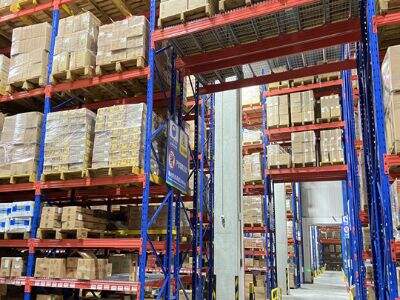You would want to give a lot of thought to how you are going to keep it organized while opening the warehouse. Racking system design is an important part of warehouse organization. Racks are used to store items in an organized way so that the items can be found and taken during the needed time. These are a few strategies for choosing, implementing and improving warehouse rack systems to ensure your warehouse operates efficiently.
WareHouse Rack System Design
Consider the space you have and the types of items you will be storing when designing your warehouse rack systems. Think about how large and heavy your products are, and how frequently you need to access them. It will also help you determine the best racks to utilize -- pallet racks, cantilever racks, etc.
When planning your rack systems, also be mindful of your warehouse height. Tall racks help you get vertical space, but they must be stable and safe. Be sure to include walkways with enough space between racks to allow workers to safely navigate around.
Row Spacing for Warehouse Racks
Proper installation of warehouse rack systems is a safety-critical concern. Follow the manufacturer’s instructions and safety equipment when putting your racks up. It’s equally important to secure your racks to the floor so they won’t topple.
Having your beams level and evenly spaced is especially important when installing pallet racks so that they are able to carry items of weight. For cantilever racks, anchor the arms adequately to prevent them from bending or breaking with heavy payloads. Proper installation of drive-in racks will ensure safe access of forklifts.
Maximizing Warehouse Rack Systems
After warehouse rack systems have been installed, it is possible to achieve even more out of them. One key is to label and organize your racks so that workers can find what they need. This ensures fewer errors and quicker order fulfillment.
Regularly inspect your rack systems for damage. Manufacturers should have rapid repairs to avoid putting workers at risk. Consider using technology such as barcode scanning to assist you in tracking your items and making picking faster.
Common Mistakes in Warehouse Rack System Design
Do not make some mistakes during the rack system design. One common mistake is not considering how much weight the racks can hold. This can cause them to break. Always adhere to the weight limits specified by the manufacturer.
Not Leaving Enough Space Between Racks for Walkways. This can make it difficult for workers to get around, and can pose a safety hazard. Wearable tech industry might be laying the foundation for creative layouts.
The following important strategies must be observed when installing warehouse rack systems. First, take clear measurements of your space and draw out your layout. This cantilever racking system ensures that your racks fit snugly and are space-efficient.
Second, your racks should be made of good-quality materials. This will extend their lifespan and spare you the cost of repairs down the road. Finally, investigate hiring a professional crew to install your racks (you’ll want to be sure they are set up safely and properly).
I hope you have gained insights into the role of designing, installing, and optimizing warehouse rack systems is an integral aspect of keeping a warehouse organized. Read these tips to maintain efficiency and productivity in your warehouse. Keep in mind your own space and item necessities, ensure that you securely set up racks, and routinely improve it for its better run. If you manage to learn from mistakes of others and apply the tips above, you will have a clean and effective warehouse on your hands.

 EN
EN
 AR
AR
 FR
FR
 DE
DE
 EL
EL
 IT
IT
 JA
JA
 KO
KO
 PT
PT
 RU
RU
 ES
ES
 SV
SV
 TL
TL
 ID
ID
 VI
VI
 TH
TH
 MS
MS
 HMN
HMN
 KM
KM
 LO
LO
 MR
MR
 TA
TA
 MY
MY
 SD
SD




